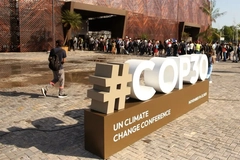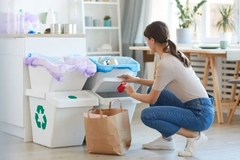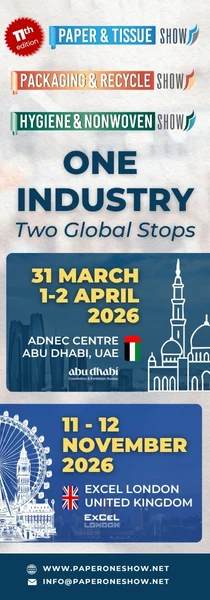Rethinking Materials Summit: Aquapak signals European turning point as barrier coating R&D advances
18 May 2023 --- At the Rethinking Materials Innovation and Investment Summit, which concluded yesterday in London, UK, Aquapak CEO Mark Lapping detailed the findings of a new report that appears to show the European packaging industry is hitting a turning point on environmental sustainability investments.
The report, titled “Sustainable Packaging in Europe: The Drive for Change,” shows that industry stakeholders are increasingly shifting the balance of materials they plan to use in the future.
The findings are drawn from research by packaging experts in the UK, Italy and Germany, revealing that 62% expect their company to increase budgets for alternative packaging materials such as fiber-based and bioplastics over the next five years, with a further 23% expecting to see budgets increase “dramatically.”
Speaking to PackagingInsights, Lapping says Aquapak used the summit to “gain information and collaborative opportunities. We recognize how important it is that the industry works together to accelerate change,” he says.
Innova Market Insights listed ”Plastics Circularity” as its top trend for 2023, noting that 61% of global consumers believe the increased use of plastic packaging is necessary – although perhaps undesirable – since the COVID-19 pandemic for safety reasons.
 Barrier coating developments are aiding industry stakeholders in transitioning toward alternative materials such as bioplastics.At the same time, consumers don’t want to be misled. The market researcher flagged that environmental claims like “carbon impact,” “reduced packaging,” and “plastic-free” on F&B packaging have almost doubled (92%) since 2018. However, the proliferation of sustainability messaging has created fears of unsubstantiated claims.
Barrier coating developments are aiding industry stakeholders in transitioning toward alternative materials such as bioplastics.At the same time, consumers don’t want to be misled. The market researcher flagged that environmental claims like “carbon impact,” “reduced packaging,” and “plastic-free” on F&B packaging have almost doubled (92%) since 2018. However, the proliferation of sustainability messaging has created fears of unsubstantiated claims.
Study findings
This rise in industry funding presented in the study includes the predicted increase in the use of multi-material (a combination of paper and plastic), new polymers and paper over the next five years, while the use of PE is set to decline.
The study shows that when it comes to the three of the most common packaging materials, the majority (83%) of respondents expect to increase the use of multi-material across their product portfolios and almost three quarters (72%) will make more use of paper over the next five years.
Regarding new materials, 69% and 65% anticipate greater use of new polymers, such as polyvinyl alcohol and bioplastics, respectively, in their packaging material. These trends are similar over a ten-year horizon, according to the findings.
The data also shows the use of PE is set to see a decline over the next five years, with 45% of respondents seeking to use less of the material across their product portfolios.
Regarding the most important attributes of the packaging material used, product protection is the key feature, with barrier properties, shelf life extension and functionality (ease of use for the end-consumer) regarded as more important than recyclability.
Barriers to change  Hydropol can replace traditional barrier coatings to enhance recyclability. Aquapak’s flagship product is the Hydropol barrier coating, a functional oxygen barrier film for complex packaging that is capable of replacing the most widely used oxygen barrier – ethylene vinyl alcohol, as part of a multilayer structure.
Hydropol can replace traditional barrier coatings to enhance recyclability. Aquapak’s flagship product is the Hydropol barrier coating, a functional oxygen barrier film for complex packaging that is capable of replacing the most widely used oxygen barrier – ethylene vinyl alcohol, as part of a multilayer structure.
“There is no one-stop material solution to solve all our problems and companies should stop claiming there is one. The materials chain is too complex, and the demands on the functionality and now the end of life mean combinations of different technologies are required,” Lapping tells us.
As an enabling technology, Hydropol can be used on its own or in combination with other materials to enhance recyclability, compostability and end-of-life options, according to the company.
“Our research shows that the European packaging industry is moving toward more sustainable materials such as paper and new polymers as they focus on the circular economy,” continues Lapping.
“However, it is also clear that the job packaging has to do is paramount, with product protection and functionality a priority. The good news is that new barrier film technologies exist, offering both performance and environmental responsibility at scale.”
Policy hurdles ahead
Recently, PackagingInsights spoke to Lapping about the lack of UK funding offered to the plastics sector, despite it being Britain’s second biggest industrial employer, according to the British Plastics Federation. The industry has an annual sales turnover of over £27 billion (US$33 billion) and employs approximately 182,000.
However, the UK’s annual spending budget, announced in March, did not prioritize funding for the industry despite the environmental pressure incurred by plastics usage and the desire of both consumers and producers to shift toward less harmful materials like bioplastics.
Lapping said that more funding is needed to connect producers with universities, where research continuously creates alternative material solutions.
“We [Aquapack] already work with nine UK universities, and there is so much going on there that if you could create an aligned structure around these clusters between research and business, it would be a great opportunity,” he said.
“We’ve had to do this with no public money or government support.”
By Louis Gore-Langton











